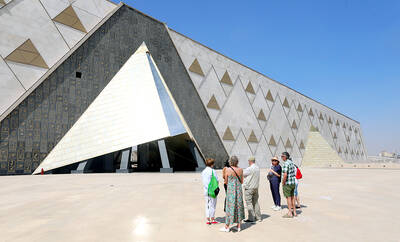International relief supplies began arriving in cyclone-ravaged Fiji yesterday, as reports emerged of widespread destruction in isolated parts of the Pacific nation.
Officials said there were estimates that half the buildings in the eastern Lau group of islands had been destroyed or badly damaged by Cyclone Tomas and two villages were believed to have been wiped out.
Aircraft from Australia, New Zealand and France started aerial surveys of the devastation and brought much-needed relief supplies for villages badly hit by the storm.
Fijian Prime Minister Voreqe Bainimarama, in a national address, called for Fijians to unite in the face of the disaster.
“The winds of Tomas reached up to speeds of ... 240kph. To state the obvious, such winds can only cause devastation,” he said.
“We, as a nation have shown that we have the resilience, the strength to bounce back from such adverse, such hard times,” he said.
New Zealand and Australia each sent a C130 Hercules aircraft packed with emergency equipment, including tarpaulins, tents and water containers after a state of emergency was declared for the north and east on Tuesday.
Aircraft and Fijian naval vessels started distributing the equipment to Fiji’s isolated north and east, which bore the brunt of the category four cyclone — the second strongest on a five point scale — on Monday and Tuesday.
Australia and New Zealand promised A$1 million (US$921,500) and NZ$1 million (US$712,800) as initial contributions to the aid effort.
Fiji-based Pacific deputy representative for UNICEF Tim Sutton said about 150,000 Fijians had potentially been directly affected by Tomas, with Bainimarama describing the damage late on Tuesday as “overwhelming.”
National Disaster Management Office operations officer Anthony Blake said unconfirmed reports painted a bleak picture of the situation in the Lau group, a string of islands in the country’s east with a population of about 11,000.
“We have got reports of at least two villages totally destroyed,” he said.
There have been no confirmed reports of deaths from Lau and residents of at least one of the destroyed villages were able to shelter in caves, Blake said.
“We are hoping there is no loss of life and all the villagers are OK and we will get emergency supplies to them,” he said.
“According to our estimates based on the worst-case scenarios of the track of the cyclone and what has happened in the north, we suspect at least 50 percent of the Lau group has been severely damaged,” he said.
The scale of the destruction and any further casualties looked set to become clearer today and tomorrow after inspections of affected areas.
Only one fatality has so far been confirmed — a woman who drowned in rough seas as the cyclone approached at the weekend — but another emergency official said on Tuesday there had been unconfirmed reports of “a few” deaths.
By yesterday, fewer than 9,000 people remained in evacuation centres throughout the country, down from about 17,000 on Tuesday, Blake said.
The main island of Viti Levu — including the popular tourist region in the west of the island — escaped the worst of the cyclone, along with the western part of the second biggest island Vanua Levu.
“We have been blessed in that our main regions and sectors have not been affected by Tomas,” Bainimarama said.

With much pomp and circumstance, Cairo is today to inaugurate the long-awaited Grand Egyptian Museum (GEM), widely presented as the crowning jewel on authorities’ efforts to overhaul the country’s vital tourism industry. With a panoramic view of the Giza pyramids plateau, the museum houses thousands of artifacts spanning more than 5,000 years of Egyptian antiquity at a whopping cost of more than US$1 billion. More than two decades in the making, the ultra-modern museum anticipates 5 million visitors annually, with never-before-seen relics on display. In the run-up to the grand opening, Egyptian media and official statements have hailed the “historic moment,” describing the

‘CHILD PORNOGRAPHY’: The doll on Shein’s Web site measure about 80cm in height, and it was holding a teddy bear in a photo published by a daily newspaper France’s anti-fraud unit on Saturday said it had reported Asian e-commerce giant Shein (希音) for selling what it described as “sex dolls with a childlike appearance.” The French Directorate General for Competition, Consumer Affairs and Fraud Control (DGCCRF) said in a statement that the “description and categorization” of the items on Shein’s Web site “make it difficult to doubt the child pornography nature of the content.” Shortly after the statement, Shein announced that the dolls in question had been withdrawn from its platform and that it had launched an internal inquiry. On its Web site, Le Parisien daily published a

China’s Shenzhou-20 crewed spacecraft has delayed its return mission to Earth after the vessel was possibly hit by tiny bits of space debris, the country’s human spaceflight agency said yesterday, an unusual situation that could disrupt the operation of the country’s space station Tiangong. An impact analysis and risk assessment are underway, the China Manned Space Agency (CMSA) said in a statement, without providing a new schedule for the return mission, which was originally set to land in northern China yesterday. The delay highlights the danger to space travel posed by increasing amounts of debris, such as discarded launch vehicles or vessel

RUBBER STAMP? The latest legislative session was the most productive in the number of bills passed, but critics attributed it to a lack of dissenting voices On their last day at work, Hong Kong’s lawmakers — the first batch chosen under Beijing’s mantra of “patriots administering Hong Kong” — posed for group pictures, celebrating a job well done after four years of opposition-free politics. However, despite their smiles, about one-third of the Legislative Council will not seek another term in next month’s election, with the self-described non-establishment figure Tik Chi-yuen (狄志遠) being among those bowing out. “It used to be that [the legislature] had the benefit of free expression... Now it is more uniform. There are multiple voices, but they are not diverse enough,” Tik said, comparing it